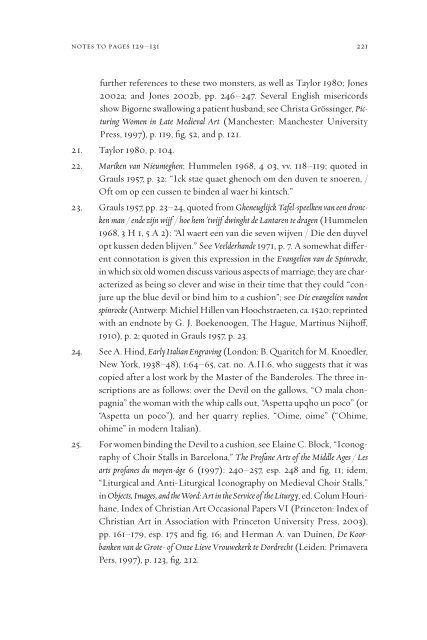Pieter Bruegel and the Art of Laughter - AAAARG.ORG
Pieter Bruegel and the Art of Laughter - AAAARG.ORG
Pieter Bruegel and the Art of Laughter - AAAARG.ORG
Create successful ePaper yourself
Turn your PDF publications into a flip-book with our unique Google optimized e-Paper software.
notes to pages 129–131 221<br />
fur<strong>the</strong>r references to <strong>the</strong>se two monsters, as well as Taylor 1980; Jones<br />
2002a; <strong>and</strong> Jones 2002b, pp. 246–247. Several English misericords<br />
show Bigorne swallowing a patient husb<strong>and</strong>; see Christa Grössinger, Picturing<br />
Women in Late Medieval <strong>Art</strong> (Manchester: Manchester University<br />
Press, 1997), p. 119, fig. 52, <strong>and</strong> p. 121.<br />
21. Taylor 1980, p. 104.<br />
22. Mariken van Nieumeghen; Hummelen 1968, 4 03, vv. 118–119; quoted in<br />
Grauls 1957, p. 32: “Ick stae quaet ghenoch om den duven te snoeren, /<br />
Oft om op een cussen te binden al waer hi kintsch.”<br />
23. Grauls 1957, pp. 23–24, quoted from Gheneuglijck Tafel-speelken van een droncken<br />
man / ende zijn wijf / hoe hem ’twijf dwinght de Lantaren te dragen (Hummelen<br />
1968, 3 H 1, 5 A 2): “Al waert een van die seven wijven / Die den duyvel<br />
opt kussen deden blijven.” See Veelderh<strong>and</strong>e 1971, p. 7. A somewhat diªerent<br />
connotation is given this expression in <strong>the</strong> Evangelien van de Spinrocke,<br />
in which six old women discuss various aspects <strong>of</strong> marriage; <strong>the</strong>y are characterized<br />
as being so clever <strong>and</strong> wise in <strong>the</strong>ir time that <strong>the</strong>y could “conjure<br />
up <strong>the</strong> blue devil or bind him to a cushion”; see Die evangelien v<strong>and</strong>en<br />
spinrocke (Antwerp: Michiel Hillen van Hoochstraeten, ca. 1520; reprinted<br />
with an endnote by G. J. Boekenoogen, The Hague, Martinus Nijhoª,<br />
1910), p. 2; quoted in Grauls 1957, p. 23.<br />
24. See A. Hind, Early Italian Engraving (London: B. Quaritch for M. Knoedler,<br />
New York, 1938–48), 1:64–65, cat. no. A.II.6, who suggests that it was<br />
copied after a lost work by <strong>the</strong> Master <strong>of</strong> <strong>the</strong> B<strong>and</strong>eroles. The three inscriptions<br />
are as follows: over <strong>the</strong> Devil on <strong>the</strong> gallows, “O mala chonpagnia”<br />
<strong>the</strong> woman with <strong>the</strong> whip calls out, “Aspetta upqho un poco” (or<br />
“Aspetta un poco”), <strong>and</strong> her quarry replies, “Oime, oime” (“Ohime,<br />
ohime” in modern Italian).<br />
25. For women binding <strong>the</strong> Devil to a cushion, see Elaine C. Block, “Iconography<br />
<strong>of</strong> Choir Stalls in Barcelona,” The Pr<strong>of</strong>ane <strong>Art</strong>s <strong>of</strong> <strong>the</strong> Middle Ages / Les<br />
arts pr<strong>of</strong>anes du moyen-âge 6 (1997): 240–257, esp. 248 <strong>and</strong> fig. 11; idem,<br />
“Liturgical <strong>and</strong> Anti-Liturgical Iconography on Medieval Choir Stalls,”<br />
in Objects, Images, <strong>and</strong> <strong>the</strong> Word: <strong>Art</strong> in <strong>the</strong> Service <strong>of</strong> <strong>the</strong> Liturgy, ed. Colum Hourihane,<br />
Index <strong>of</strong> Christian <strong>Art</strong> Occasional Papers VI (Princeton: Index <strong>of</strong><br />
Christian <strong>Art</strong> in Association with Princeton University Press, 2003),<br />
pp. 161–179, esp. 175 <strong>and</strong> fig. 16; <strong>and</strong> Herman A. van Duinen, De Koorbanken<br />
van de Grote- <strong>of</strong> Onze Lieve Vrouwekerk te Dordrecht (Leiden: Primavera<br />
Pers, 1997), p. 123, fig. 212.












